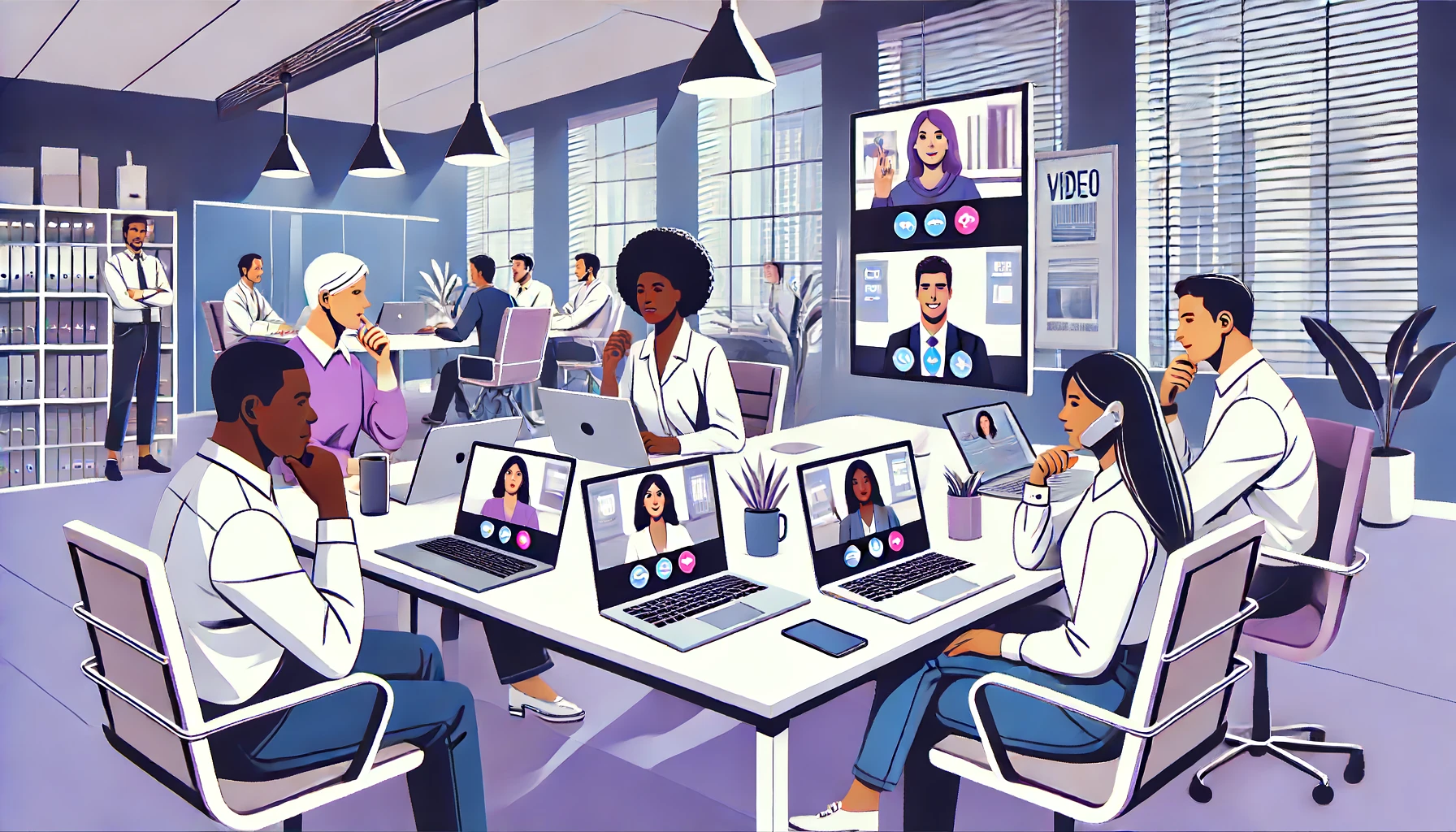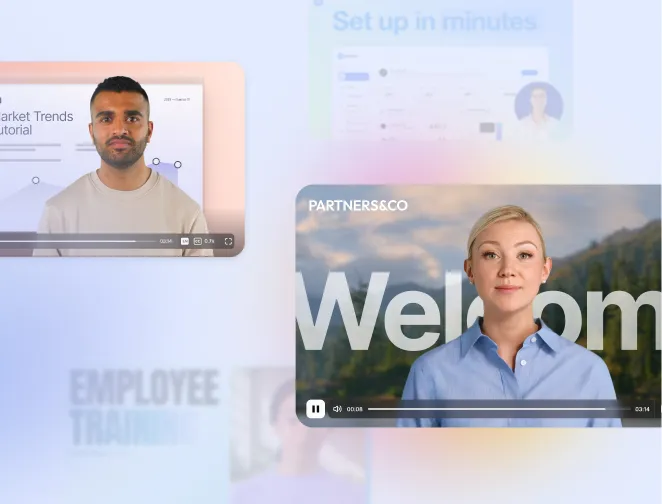
How to Upgrade Your Internal Communications Strategy With Synthesia
Create AI videos with 230+ avatars in 140+ languages.
Your internal communications aren’t landing.
Employees skim critical updates, frontline workers miss announcements, and the same questions keep resurfacing, which erodes trust and wastes time.
The good news: with a focused internal communications strategy and AI video, you can turn scattered messages into clear, two-way conversations that drive action.
Clear internal communication can make or break your company culture. When employees understand what's happening and why, they're more engaged, productive, and likely to stick around.
An effective internal communications strategy transforms scattered messages into purposeful conversations that align your entire organization. I'll explore how you can upgrade yours using AI video technology that makes communication both simpler and more impactful.
From my conversations with communication leaders, I hear the same frustrations repeatedly: email open rates hovering around 20-30%, frontline workers never seeing critical updates, and the same questions being asked over and over because information isn't sticking.
One HR director told me their policy updates were taking 40+ hours to produce, only to be skimmed by less than half their workforce. These aren't just annoyances—they're costing organizations real money and engagement.
Here's a quick example from our CEO, Victor (hint: it's actually a Synthesia video made with Victor's personal avatar).
What is an internal communications strategy?
Think of an internal communication strategy as your organization's information blueprint. It's a structured plan that determines how information flows within your company—which messages get shared, when they're delivered, who receives them, and through which channels. But it's more than just a distribution plan.
What separates a real strategy from ad-hoc messaging? Consistency and purpose. While research shows 52% of organizations still rely on generic messaging, strategic internal communication creates targeted, two-way conversations that actually resonate with different employee groups. It's not just about broadcasting information—it's about ensuring understanding and enabling dialogue.
Poor internal communication costs U.S. businesses up to $2 trillion annually in lost productivity. Only 13% of employees strongly agree that their leadership communicates effectively.
Why? Information overload, wrong channels, and lack of personalization mean critical messages get lost in the noise. Unlike ad-hoc messaging, a strategic approach creates consistency, builds trust, and supports broader organizational objectives through planned communication tactics.
Step 1: Audit your current communication challenges
Start by identifying where your current internal communications fall short:
- Document engagement metrics for existing channels (email open rates, intranet visits)
- Map communication pain points across departments and regions
- Calculate time spent on repetitive communication tasks by leadership and HR teams
How to conduct your audit effectively:
- Employee listening sessions: Host focus groups across departments and seniority levels to understand how different groups consume and prefer information
- Channel performance analysis: Compare which channels get real engagement versus which get ignored—you might be surprised to find your expensive intranet has minimal traffic
- Communication journey mapping: Track how information flows during key employee moments like onboarding, role changes, or major announcements
- Time-cost analysis: Calculate how many hours leadership spends recording, editing, and re-recording messages versus the actual engagement they receive
Step 2: Start with high-impact, low-risk content
Transform these common internal communication types first:
- Routine updates: Replace text-heavy emails with brief, engaging video announcements.
- Policy communications: Convert complex policies into visual explanations—I've seen companies achieve up to 600% higher engagement with video formats.
- Welcome messages: Create consistent executive greetings for new hires that establish connection from day one.
- Year-end reviews: Switch from dense newsletters to concise video summaries with key highlights.
I've found that the biggest wins come from replacing the communications that consume the most time but get the least engagement.
I suggest that you pay special attention to frontline and deskless workers—they're often the hardest to reach but need information most urgently. I've seen organizations struggle because their primary channels (email, intranet) simply don't work for employees without regular computer access.
Video works particularly well here because it's mobile-friendly and doesn't require employees to read lengthy documents during breaks.
Step 3: Implement video-based internal communication strategies
Use AI avatars for consistency: Create branded video presenters that maintain visual identity across all communications.
Implement easy translations: Ensure consistent messaging across global teams with automatic video translation in 140+ languages.
Add accessibility features: Include subtitles and transcripts to make communications available to all employees.
Enable quick updates: Make content adjustments in minutes when information changes without recreating entire videos.
Step 4: Scale across different communication types
Apply these internal communication best practices across various message types:
- Leadership updates: Replace long executive emails with personalized video messages that convey tone and build connection.
- Change management: Use video to communicate organizational changes with clarity and empathy.
- IT communications: Transform technical updates into digestible visual content that non-technical employees can understand.
- HR announcements: Make benefits, policy updates, and compliance information more engaging through conversational video presentations.
Remember that effective internal communication isn't just about broadcasting information—it's about creating dialogue.
I recommend including clear feedback mechanisms in your videos: add a Slack channel reference for questions, embed a quick poll link, or direct viewers to a FAQ page where they can see answers to common questions.
The goal is to move from "we told them" to "they understood and engaged."
Step 5: Optimize your content strategy
Keep videos concise: I recommend aiming for 2-3 minutes maximum to maintain attention and improve retention.
Use consistent presenters: Build familiarity by using the same AI avatars for specific communication types.
Create templates: Develop standard formats for recurring communications to maintain visual consistency.
Batch similar content: Produce multiple related videos in one session to maximize efficiency.
One pattern I see consistently: organizations that create 3-4 standard templates see 60% faster production times within a month.
It's all about creating a recognizable communication rhythm that employees come to expect and engage with.
Step 6: Measure and improve results
In my experience, the most revealing metric is often what stops happening: fewer repeated questions in Slack, fewer errors in process execution, and fewer escalations to leadership for clarification.
These signal that your communication is actually landing. Companies implementing these strategies report employees are 6-7x more likely to engage with short videos than text emails.
Having said that, there's a few quantitative and qualitative metrics you can monitor to track your progress.
Quantitative metrics to track
- View rates: Percentage of employees who watched each video (aim for 70%+)
- Completion rates: Percentage who watched videos entirely (target 80%+)
- Engagement actions: Clicks, comments, or responses (good = 15%+ interaction)
- Time savings: Hours saved compared to traditional methods
- Content creation efficiency: Hours per video versus traditional production methods
- Support ticket reduction: Decrease in questions about covered topics (target 30–40% reduction)
- Information adoption speed: Time from announcement to successful implementation
Qualitative indicators of success
- Employee sentiment improvements: Surveys and listening sessions
- Quality of questions being asked: Strategic vs. basic clarification requests
- Manager confidence: Ability to cascade messages to their teams
- Reduction in “I didn’t know about that” moments: During reviews or check-ins
Advanced internal communication tactics
Executive presence: Create custom avatars for senior leaders to scale their visibility without requiring their time for filming.
Department-specific applications:
- IT teams: Visual demonstrations of system changes
- HR departments: Engaging policy and benefits explanations
- Operations: Visual guides for complex procedures
Audience segmentation and personalization
Generic messages fail because they try to speak to everyone and end up resonating with no one. With 52% of organizations still using one-size-fits-all messaging, there's a huge opportunity to stand out through personalization.
The executives I work with are often surprised by how much their visibility increases when they're not spending hours in recording studios. Instead, they can focus on strategy while their avatar handles routine communications.
About the author
Strategic Advisor
Kevin Alster
Kevin Alster is a Strategic Advisor at Synthesia, where he helps global enterprises apply generative AI to improve learning, communication, and organizational performance. His work focuses on translating emerging technology into practical business solutions that scale.He brings over a decade of experience in education, learning design, and media innovation, having developed enterprise programs for organizations such as General Assembly, The School of The New York Times, and Sotheby’s Institute of Art. Kevin combines creative thinking with structured problem-solving to help companies build the capabilities they need to adapt and grow.

Frequently asked questions
How do I integrate AI video into our internal communications strategy without creating more complexity?
Start by identifying one high-impact communication type that currently takes significant time but gets low engagement, such as policy updates or weekly team briefings. Replace just this one communication format with AI video first, using templates and consistent AI avatars to maintain familiarity while reducing production time from hours to minutes.
The key to avoiding complexity is standardization: create 3-4 video templates for your most common communication needs, establish a simple approval workflow, and batch similar content creation. This approach typically reduces production time by 60% within the first month while actually simplifying your process since you're eliminating the need for recording equipment, scheduling conflicts, and multiple revision cycles that traditional video requires.
Which metrics should I track to measure the success of AI-driven internal communications?
Focus on both engagement metrics and outcome indicators to get a complete picture of your AI video communication effectiveness. Track quantitative metrics like view rates (aim for 70%+), completion rates (target 80%+), and time saved in content creation, alongside qualitative indicators such as the reduction in repetitive questions, improved employee sentiment scores, and faster information adoption across teams.
The most revealing success metric is often what stops happening: fewer repeated questions in Slack channels, fewer process errors, and fewer escalations to leadership for clarification. Companies implementing AI video strategies report 6-7x higher engagement compared to text emails, but the real value shows up in support ticket reductions of 30-40% for topics covered in videos, indicating that information is actually being understood and retained rather than just consumed.
How can Synthesia help me reach frontline and deskless workers who miss email and intranet updates?
AI video transforms how you reach frontline workers by creating mobile-friendly, visual content that employees can watch during breaks without needing computer access or time to read lengthy documents. You can create brief 2-3 minute videos with AI avatars delivering key updates, safety protocols, or policy changes that workers can access on their phones anytime, anywhere.
The platform's automatic translation capabilities mean you can record once and instantly create versions in 140+ languages, ensuring every worker receives information in their preferred language. Adding subtitles and visual demonstrations makes complex procedures easy to understand even in noisy environments like warehouses or retail floors, while consistent AI presenters build familiarity and trust that encourages regular viewing of important updates.
Can I localize leadership updates for global teams without re-recording every video?
Yes, you can create leadership messages once and automatically generate localized versions that maintain the speaker's tone and delivery style across all languages. Using custom AI avatars of your executives, you can produce a quarterly update or important announcement and then use one-click translation to create versions in multiple languages while preserving the original message's nuance and leadership presence.
This approach solves the traditional challenge of global communications where executives either need to re-record messages multiple times or rely on subtitles that lose personal connection. The AI maintains consistent messaging across all regions while allowing for cultural adaptations in the script, ensuring that a CEO's message to teams in Tokyo feels as personal and relevant as the one delivered to London or New York offices.
How does Synthesia ensure privacy, consent, and security when using AI avatars and voice for internal communications?
Synthesia implements strict consent protocols requiring explicit permission before creating any custom avatar or voice clone, with clear documentation and verification processes to protect individual rights. The platform is SOC 2 compliant and follows enterprise-grade security standards, ensuring that your internal communications remain confidential with encrypted storage and transmission of all video content and data.
For internal communications specifically, you maintain complete control over who can create content with executive avatars, which messages get approved for distribution, and where videos are stored and accessed. The platform includes built-in governance features that allow you to set permissions, track usage, and ensure that AI-generated content aligns with your organization's ethical guidelines and communication policies while maintaining transparency about when AI technology is being used.














